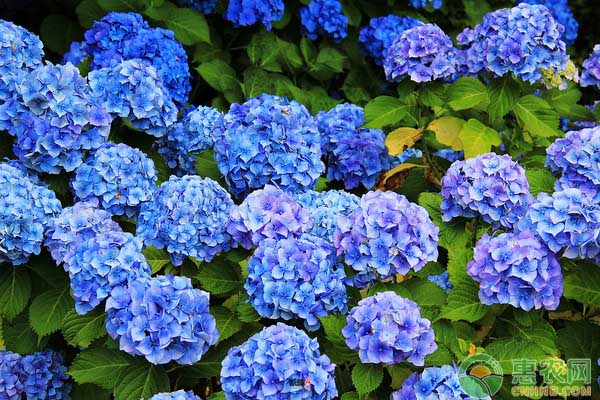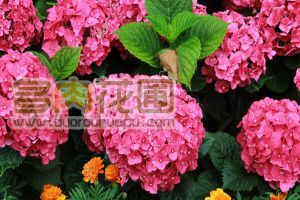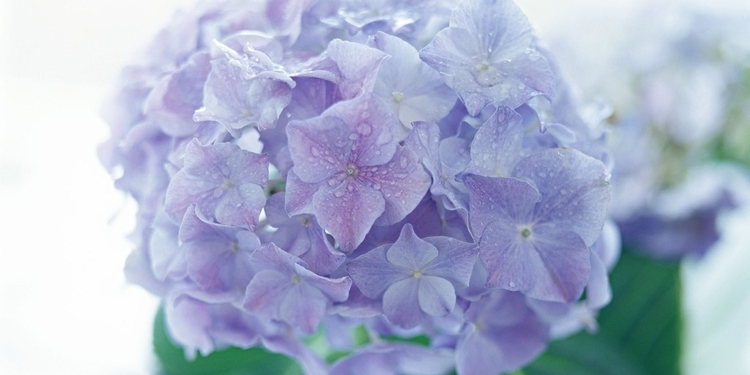How to breed and cultivate hydrangea?
[morphological characteristics] Hydrangea is a deciduous shrub with a height of 3 to 4 meters. Lower branches stout, glabrous, lenticels obvious. Leaves opposite, large and glossy, Obovate to elliptic, 7-15 cm long, leaf margin coarsely serrate, both surfaces glabrous or only dorsal veins hairy. Terminal corymbose, subglobose. Flowers up to 20 cm in diameter, almost all sterile flowers, white, pink or blue, extremely beautiful.
[origin and habits] Hydrangea originated in China and Japan. Like warm and humid climate, not cold-resistant. Like yin, avoid direct light exposure, is a short-day plant. Like moist, humus-rich and well-drained slightly acidic soil. The suitable temperature for growth is about 20 ℃, and the overwintering temperature is above 5 ℃.
[propagation] Hydrangea can be propagated by cutting, striping, ramet and other methods. The cutting method is more commonly used. In early summer (usually from May to July), sturdy and full annual branches or newly sprouted tillering buds were selected as cuttings, cut into a length of about 10 cm, inserted into a bed with coarse sand or vermiculite as substrate, shaded after insertion, maintained humidity, and rooting for about 30 days. From November to December, combined with the wiping head of the old plant, the branches wiped by the old plant can be used as cuttings for cutting. after cutting, the temperature can be kept at about 15 ℃ and it can take root in about 45 days. Ramets are carried out before sprouting in autumn, winter or spring. Striping is carried out in the early part of the growing season.
Potted soil, made of pine needle soil, rotten leaf soil or sandy loam mixed with peat soil. Hydrangea for fleshy roots, watering should not be too much, but foliar spray water to prevent rotting roots. Prevent stagnant water in the basin during the rainy season. Only keep the soil 30% wet in winter, no dry or watered. Hydrangea like big fertilizer, generally apply dry fertilizer once a month, liquid fertilizer once a week. The color of hydrangea varies with soil acidity and alkalinity, generally blue at pH4~ 6 and red above pH7. If you want to get blue hydrangea, dissolve a tablespoon of alum in 2.5L water and water the flowers with this water from germination to flowering. The flowering habit of hydrangea is that the new shoots of inflorescences are all from the strong branches of the previous year, so pruning should be carried out after flowering, usually in early spring from February to March, the weak branches, withered branches and flowering branches are cut off, so as to promote the growth of new branches. In order to renew the old potted plant, we should wipe the head from November to December, count from the root, leave 2 or 3 buds, and cut off the upper branch. When picking leaves in March, 3-4 robust buds can be retained per plant, and the rest should be removed. Hydrangea blossoms at the top of the stem, the bouquet is larger, should be set up bracket binding, so that the flower stem erect, plant shape plump.
How to cultivate hydrangea? Detailed explanation of cutting cultivation techniques of Hydrangea
How to raise hydrangeas? Hydrangea is shaped like hydrangea and likes rich and moist soil. It is a very delicate flower. Most varieties of hydrangea can only be propagated reliably by rooting cuttings. Let's learn the cutting cultivation techniques of Hydrangea.

Preparatory work
Cleaning is essential for successful rooting of hydrangea. Wipe the trimming blade with a rag soaked in alcohol. This kills diseased organisms and prevents pathogens from spreading. Clean the flowerpot. After rinsing in clean water, soak the flowerpot in 1 part of household bleach to 9 parts of water solution for at least 5 minutes. Rinse clean with clean water. Fill the basin with rooting soil (such as the equivalent part of peat and perlite) in the 2-3cm at the edge. Time propagates in the middle and late summer, when the flowers have formed and the stems are still green.
Looking for branches
Find the Hydrangea stem that has not yet blossomed because flowering reduces the concentration of plant hormones in the stem. This hormone promotes rooting. You can test the correct stem development by bending the green stem.
Cut
With a clean pruning shears, remove the top part of the stem that contains several leaves. Cut the stem below the node, which is the area where leaves appear. Cut the stem into shorter pieces, each about 10CM, and contain three to four nodes. Clean up the alcohol pruning shears between each stem cut from the bushes.
Prepare to plant
Prepare a small clean container with some rooting hormones in it. Do not soak the cut branches into the entire container that may contaminate the rooting hormone. If there are leaves, remove the lower two leaves from the cut. Immediately soak the base of the stem in the rooting hormone and apply the end of the fresh cut and any wound caused by the removal of the leaves. Cut off the outer half of the remaining leaves to reduce the use of water when cutting.
Maintain humidity
You need to keep cutting until it takes root, so it needs a wet environment. Place a large, transparent plastic bag at the cutting place and, if necessary, take it off the branch and insert the stump into the pot mixture. Put the cut in a cool place. It will take root in about a week.
How to reproduce hydrangea and the method of propagation of hydrangea
How do hydrangeas reproduce? Hydrangea cultivation is often dominated by asexual reproduction, such as ramet, striping, cutting and so on, especially for varieties or varieties with special ornamental characteristics. Asexual reproduction is an important means to keep the characteristics of offspring consistent with that of mother plants. Let's see how hydrangeas reproduce.
Propagation methods of Hydrangea 1. Propagation methods of Hydrangea
It should be carried out before germination in early spring, which can be combined with changing pots to separate the sprouting seedlings from the roots. The propagation of Hydrangea should be carried out before sprouting in early spring. Separate the rooted branches from the mother plant, pot directly, watering should not be too much, maintain in the semi-shady place, wait for new buds to sprout and then transfer to normal maintenance. Striping propagation can be carried out during bud germination, grow after 30 days, cut off from the mother plant in the following spring, transplant with soil, and blossom in the same year.
2. The method of striping propagation of Hydrangea.
A, the family had better use "high branch crimping method". Select 2-year-old sturdy branches, do circular peeling at 4 cm to 5 cm below the internodes, that is, clip the stem once with scissors, and turn once with scissors at 2 cm below the knife edge, peeling off the cortex between the two edges and exposing xylem. Then tie it into a bag with a plastic film 5cm to 6cm below the edge of the knife, put moss or peat soil in the bag, tie the mouth of the bag tightly, and secure the branches of the bag with a column and irrigate from the mouth of the bag.
B, in general, pour water into the bag once every 4 to 5 days. From 25 to 30 days, healing tissue will be produced at the ring peeling, and it will take root in about 50 to 60 days. When the young roots change from white to yellowish brown, the mother can be cut off and planted in a pot.
C. The striping should be carried out during the rainy period, select biennial branches and burn them in appropriate parts, wrap them with half-bamboo tube or film with nutritious soil, maintain soil moisture, root after 1 month, cut off the mother body in the next spring, and plant it in the basin with dirt.
3. Cutting propagation method of Hydrangea.
Cuttings can be carried out except in winter. Cutting twigs in early spring, cuttings should have 2-3 nodes, and the lower leaves should be removed to reduce water evaporation. The young lateral branches germinated from the trunk and lateral branches can also be cut from the base in the summer peak season, and the leaves can be inserted into the plain sandy soil and preserved and moisturized in the shade place. the roots can be rooted in about 20 days, and the survival rate is high.
4. Tissue culture and propagation of Hydrangea.
Using dormant buds as explants, adventitious buds were cultured on MS medium supplemented with 6-benzylaminoadenine 0.8mg / L and indole acetic acid 2mg / L after regular disinfection. When the seedling height was 2-3 cm, it was transferred to 1/2MS medium supplemented with indole acetic acid 2.0mg / L, and grew into complete plantlets.
- Prev

How to propagate hydrangea by bud insertion?
Hydrangea is the so-called fighting ball and hydrangea. This shade-tolerant ornamental plant usually propagates by cutting. The reproduction coefficient of this method is low. In order to propagate hydrangea rapidly, this paper introduces the method of propagating hydrangea with high propagation coefficient and bud insertion. Spring
- Next

Propagation method of Hydrangea
Like a warm, humid and semi-shady environment. It is suitable for slightly clayey soil which is fertile, rich in humus and well drained, and the suitable soil pH value is 4.0-4.5. 1. Propagation methods (1) ramet propagation should be carried out before germination in early spring, which can be combined with changing pots to separate the sprouting seedlings from the roots.
Related
- Fuxing push coffee new agricultural production and marketing class: lack of small-scale processing plants
- Jujube rice field leisure farm deep ploughing Yilan for five years to create a space for organic food and play
- Nongyu Farm-A trial of organic papaya for brave women with advanced technology
- Four points for attention in the prevention and control of diseases and insect pests of edible fungi
- How to add nutrient solution to Edible Fungi
- Is there any good way to control edible fungus mites?
- Open Inoculation Technology of Edible Fungi
- Is there any clever way to use fertilizer for edible fungus in winter?
- What agents are used to kill the pathogens of edible fungi in the mushroom shed?
- Rapid drying of Edible Fungi

